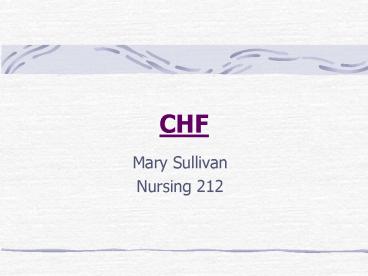CHF - PowerPoint PPT Presentation
1 / 28
Title: CHF
1
CHF
- Mary Sullivan
- Nursing 212
2
CHF
- Definition- failure of the left ventricle to pump
sufficient blood to meet the metabolic needs of
the body for oxygen and nutrients - Underlying mechanisms
- a) impairment of contractility
- b) decreased cardiac output
3
CHF
- 700,000 people in US die of heart disease, 50
(350,000) from CHF - 2.5-3 million people have CHF
- 400,000-500,00 new cases diagnosed annually
- death rates highest in men, African Americans,
and the elderly
4
Risk Factors
- -Overt CAD
- -Advancing Age
- -Hypertension
- -Smoking
- - Hypercholesteremia
- -Obesity
- -Diabetes Mellitus
5
Pathology of CHF
- Systolic failure-results in impaired ventricular
emptying and low forward blood flow - Diastolic failure-results in impaired ventricular
filling with high filling pressure and venous
engorgement in the pulmonary and systemic systems
6
Mixed Systolic and Diastolic Failure
- -Seen in dilated cardiomyopathy (DCM)
- - Results in poor systolic function
- - Walls of the left ventricle unable to
relax - results
- - poor ejection faction
- - high pulmonary pressure
- - biventricular failure-ventricles
dilated, - - poor filling, unable to empty
7
Characteristics of CHF
- - LV Failure
- -Decreased exercise tolerance
- -Diminished quality of life
- -Shortened life expectancy
8
Symptoms of CHF
- Decreased Cardiac Output
- -decreased blood pressure
- -decreased renal perfusion
- -poor exercise tolerance
- -ventricular dysrhythmias
9
LVF
- most common
- retrograde from LV to pulmonary system to RV
- increased pulmonary pressure cause fluid
extravasation from pulmonary capillary bed to
interstitium and alveoli resulting in pulmonary
congestion/edema
10
Causes of LVF
- CAD-Atherosclerosis
- Hypertension
- Dysrhythmias
- Cardiomyopathy
- Valvular problems-rheumatic disease
- Congenital
11
Symptoms of LVF
- Dyspnea
- Orthopnea
- PND
- cough-dry, non-productive
- fatigue
- restlessness and anxiety
12
RV Failure
- Causes backward flow to RA and then venous
circulation - systemic circulation results in
- - peripheral edema
- -hepatomegaly
- -splenomegaly
- -JVD jugular venous dissension
- -GI congestion
13
RVF
- Primary cause of RVF is LVF
- LV fails resulting in increased Pulmonary
Congestion, increased Pulmonary Pressure,
Pulmonary Hypertension, RV Failure,and RV
Hypertrophy
14
CAUSES of RVF
- Cor Pulmonale
- COPD
- Asthma
- Emboli
- RV Infarction
15
Symptoms of RVF
- Dependent Edema- feet, ankles, legs and
- thighs, genitalia area
- Hepatomegaly- ascites, pressure on the
- diaphragm and respiratory distress
- Gastrointestinal- anorexia, n/v
- Nocturia
- Weakness
16
(No Transcript)
17
Diagnostic Studies
- History and Physical Examination
- Chest X-Ray (increased fluid in lungs ,
- increased size of heart)
- EKG - LV Hypertrophy
- Echocardiogram- (size)
- Cardiac Catheterization and Angiography
- Hemodynamic Monitoring (assess function
- by pressure readings)
18
Acute Heart Failure-Pulmonary Edema
- Life Threatening
- Increased Pulmonary Venous Pressure caused by LVF
- Engorgement of Pulmonary Vascular System
- Lungs are less compliant
- Increased resistance to small airways-increased
respirations, decreased PO2
19
Acute Heart Failure-Pulmonary Edema
- Interstitial Edema-results in Tachycardia
- Alveolar Edema-airways filled with fluid
resulting in decreased PO2, increased PCO2, and
acidemia
20
S/S of Acute Heart Failure
- Agitation
- Dyspnea-respirations above 30 minute
- Orthopnea
- Wheezing, Coughing
- BP elevated or lowered
- Lung Auscultation-rales, wheezes or rhonchi
- Skin- pale, cyanotic, cold or clammy
21
GOALS OF TREATMENT
- Increase LV Function
- Decrease intravascular volume
- Decrease Venous Return
- Decrease Afterload
- Improve Gas Exchange and Oxygenation
- Increase Cardiac Output
- Decrease Anxiety
22
Increase LV Function
- DIGITALIS
- -Digitalizing or Loading Dose
- -Maintenance or Daily Dose
- Toxic Effects include
- -n/v, anorexia
- -bradycardia, PVCs, Bigeminy,PAT
- -blurred, yellow, or green vision
- -weakness mental depression
23
DECREASE INTRAVASCULAR VOLUME
- DIURETICS -decrease venous return, decrease
preload, and increase cardiac output - Quick Acting Loop Diuretics-
- Furosemide (Lasix)
- Ethacrynic Acid (Edecrin)
- Bumex
24
DECREASE INTRAVASCULAR VOLUME
- Nitroglycerin Intravenously-
- -vasodilator
- -decreases volume by decreasing
- preload
- -increases coronary artery perfusion
- thus increasing oxygen to the
- myocardium
25
Decrease Venous Return
- High Fowlers Position with feet dangling
- Rotating Tourniquets
26
DECREASE AFTERLOAD
- Afterload- amount of work LV has to perform to
eject blood to systemic circulation - -IV Nitroprusside (Nipride)
- -vasodilator- decreases preload and
afterload (arteriole and venous dilation) - -increases myocardial contraction, in-
- creases PO2, decreases pulmonary
- congestion
27
Decrease Afterload
- Morphine
- Ace Inhibitors- blocks angiotensin 11
- examples-Captopril (Capoten)
- Enalapril (Vasotec)
- Lisinopril (Prinivil,
Zestril )
28
Nursing Interventions
- - Promoting Rest
- -Positioning of Client
- -Relief of Anxiety
- -Avoid Stress
- - Client Education/ Home Care































